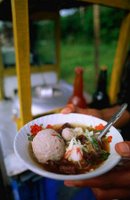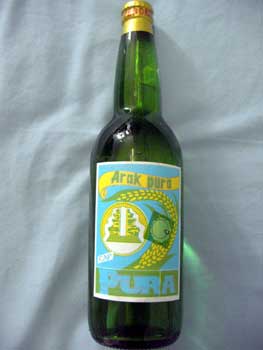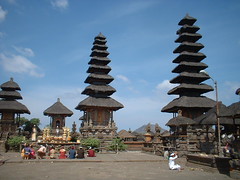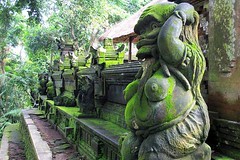Friday, July 14, 2006
Respect the temple
Bali woman adat dress consists of "Kebaya" long sleeved shirt, saput, and sarung. Senior Bali women usually wear wig and striking accessories on head, neck and wrist. Among women in Bali the most popular materials for kebaya is brocade fabric, which is semi transparent. Usually among the girls strong transparent brocade is also getting more and more popular, although protest come from older generation of Bali saying it is not polite. It is not really known, when kebaya style was introduced in Bali. Study from Bali iconography do not give any clue on this, that the style is belongs to their cultural heritage since in other areas of Indonesia Kebaya is also in use since immemorial time. It is well known that the kebaya style is belong to Malay dress style, and it was probably this type came to Bali and modified a little bit with Bali art taste. Today the use of kebaya shirt for women is even more and more popular with the availability of very thin and transparent brocades. This way of dressing has invited protest from those older people that feel this is not suitable for public areas, furthermore to be used to enter a temple. But in Bali, the tradition of religion is not as strict as other religion that give punishment to their devotee. Balinese more in the side of suggesting to wear the so called polite dress. The understanding of polite dress in Bali is that a dress that covers most of the body, but not total coverage like in Moslem does.
Among hundreds of temple in Bali, after an extensive study on the field and bibliography the important aspect of Bali temple zoning is the concept derived from original orientation, that the higher the place, the more sacred it will be. The high place in Bali is considered as the abode of the holy spirits or Dewa ( gods ). This thought has shown to us that most of the temple in Bali are located on high place, even on the peak of mountain. On the plain land where temples are laid out, this concept is translated into level of yard or using stepped pyramid. The level of the yard reflecting the level of sacredness of temple zone. Various temples in Bali showing the concept of stepped pyramid even Besakih temple is considered to have been laid out with the basic zoning concept of stepped pyramid.
* First courtyard, in Bali word it is called "jabaan" means outer courtyard. Into this area everyone can enter this yard, normally no restriction
* Second courtyard, or jaba tengah or first inner courtyard. Medium temple usually have only one courtyard. This zone is the place of people in preparing rituals materials.
* Inner courtyard or jeroan. On this zone are various shrines of gods and holy spirits.This is considered the holiest place of Bali temple.
The jaba tengah and jeroan have some strict restriction for everyone with complicated sanction for offender in the form of Bali ritual. Depending on the type of the infringement, for example, a Bali woman comes to period found to enter a temple will be fined to conduct a ritual called "mecaru". The cost of mecaru is not expensive but the ritual's procedure is complex and time consuming.
* For Balinese themselves below are restriction for entering temple.
* If one of Bali family member is dead. This restriction will continue to ban the family member to enter the temple until after certain days that have been accepted by the member of the village meeting.
* Bali woman comes to period or basically human blood can't be dropped in the temple. This has a big effect on the value of the temple, if it is found to happened a big ceremony must be conducted to clean symbolically the area.
* At some temple, child under2 years can't enter the temple, usually in the village temple called "Pura Dalem"
* In some temple in Bali strictly forbidden to enter some kind of animals, or let animal centering the temple.
* Insufficient Bali adat dress as mentioned above.
* Balinese couple just married before conducting ceremony of "mesakapan"
The peak of the temple ceremony is when the devotees ( Balinese ) are sitting together for praying, conducted by "pemangku" a Bali ritual leader. Everyone will be sitting with flower and incense in hand. During this time it is not polite to everyone to walk in front of those sitting people. If taking a photograph or seeing them is better from left or right sides. Since on their front is considered to be the empty space without any obstacle
Thursday, July 13, 2006
Ngaben, next step of life

Ngaben
Originally uploaded by BarryKusuma.
Balinese religion is based on respect for and worship of God and ancestors, and is a combination of Hindu elements and indigenous Balinese culture. After death, the body must be dissolved and returned to its original elements. The cremation ritual is a purification rite which frees the roh (soul or spirit) from its temporary earthly house and facilitates its journey to its next existence.
After a death, the whole village helps with preparations for the cremation. The mayat (dead body) is laid out in a special house to be bathed and prepared. Meals are prepared and offered to the deceased as normal. Around the body and entrance to the house are placed damar kuranung (lamps), which notify people of the death and help facilitate the soul's journey and to keep the person's memory alive.
The night before the cremation, holy water is collected from the temple and used in preparation of the body and during the cremation. Any important ceremonies which have been missed during the deceased's lifetime must be carried out prior to cremation. Some Balinese are buried until the cremation can be organised or to wait for an auspicious date. The bones are exhumed a few days before the cremation then prepared in the same way as the whole body.
All the village unites for the cremation, which is a joyous occasion. After cremation, the ashes are placed in the sea - achieving final separation of the soul from the body.
Cremation scene
The tower containing the remains is taken to the cremation ground. Depending on the size of the ceremony, either the eldest son or a priest stands on the tower holding a 'paradise bird' which will guide the spirit to heaven. At the cremation ground the corpse is placed in the carved figure of a cow (a sacred animal).Ider-ider paintings tell a story using a sequence of scenes on a horizontal strip in the style of a comic. They were tied under the eaves of temple or palace pavilions and read by walking around the building. This segment shows the cremation of Abimanyu, the heroic son of Arjuna, who died from being pierced by 100 arrows. One of his wives, Uttari, is pregnant and not permitted to join her husband in death, but his other wife Sundari leaps from the ramp into the fire, where her soul is released and flies upward in the form of a bird.
The tika is a complex 210-day-per-year calendar mainly used by Balinese ritual experts to advise the Balinese villager of the most appropriate day for undertaking any important activity, such as a cremation
In the past, an anthropomorphic (human-like) figure made from Chinese coins and cotton thread was placed lengthwise on the body after death. Called the 'measure', it ensured that after rebirth, the deceased's bones would be in the right dimensions and arrangement. Today, Chinese coins, rice and other offerings are thrown from the cremation tower as it travels to the cremation ground.
Wednesday, July 05, 2006
Thursday, June 22, 2006
Tulamben wreck

Dive operators in
The wreck dive site in Tulamben beach Bali is a United States Army transport and was built at the
The ship was re-measured at 6,211 tons, was bound from Australia to Philipina on January 11, 1942 with a cargo of railway parts and rubber for the war effort when she was torpedoed by Japanese submarine I-166 about 10 mi (19 km) southwest of Lombok Strait. They towed the damaged ship in tow attempting to reach Singaraja, the Dutch port and administrative centre for the Lesser Sunda Islands, on the north coast of Bali. However she was taking too much water and so was beached on the eastern shore of
In 1963 the tremors associated with the eruption of Mount Agung caused the vessel to slip off the beach, and she now lies on the sand slope, is at 5-10m. Depth along the middle of the wreck is 16-20m. The lower edge of the wreck furthest down the slope is 20-28m (at high tide). The wreck is 120m long, it's pretty broken up but you can still see the guns, toilets, boilers , anchor chain, etc. It is a lovely dive site, possibly the world's easiest wreck dive, providing one of the most popular dives off
You can also snorkel on the wreck - the highest point of the stern is about 4m below the surface.
Visibility is usually 18-25m, lower when it has been raining. There is rarely a current present; at most it will be mild. During the 3 days before the full moon, there are usually waves. The air temp is 25-32 degrees, the water 26-28 degrees.
The wreck is very popular with photographers as it is totally encrusted in anemone, gorgonians and corals. The black sand provides an excellent colors contrast for the incredible variety of marine life, which includes a huge school (literally 100s) of 10-12inch silver fish called Big-Eyed Trevally and over 400 other species of fish.
From the Goatfish and Wrasse that nibble around your feet and fins during entry/exit to the Unicorn fish and Surgeonfish which make a (slightly alarming the first time you see them!) beeline for your mask as you swim down towards the Wreck.
It is quite difficult to list what you will see because you'll see just about everything in any Indo-Pacific Reef Guide book if you dive here. From the minute Anglerfish, neon nudibranches, Ghost Pipefish, shrimp/goby sets; through to the areas of Garden Eels and multi-colored clouds of anthias and damsels and on to the schools of Sweet lips, Batfish, fusiliers, Butterfly fish, the variety is amazing. Then there are the invertebrates, the hard and soft corals, black corals, sponges with crinoids, sea fans, tunicates.
Night diving on the wreck is great especially during the full moon. You may see Spanish Dancers, flashlight fish, phosphorescence.
Great balls of fire

Bakso ("BAH-soh", meatball) soup is cheap and tasty any time of the day. The vendors wander the streets with their steaming wooden food carts, and are easily located by the 'tink-tink-tink' sound of a spoon hitting a soup bowl. The soup is a small-ish bowl of MSG-laden meaty broth with some thick yellow egg noodle, meatballs, and the optional extras of: fried wanton, fried tofu, hard-boiled egg and occasionally some others. Add some mild chili sauce and sweet soy for a bit more flavour.
The Balinese Hindu
 Balinese are Hindus and describe themselves as such. They are well aware that their tradtition of Hinduism is different from those in India and elswhere, although they enjoy the Ramayana and the Mahabharata in arts and traditions. They can be described as a different sect of Saivites and should redefine Hinduism and Saivism as having another sect, the Balinese Saivite Hindu sect; this being the seventh sect of Saivism.
Balinese are Hindus and describe themselves as such. They are well aware that their tradtition of Hinduism is different from those in India and elswhere, although they enjoy the Ramayana and the Mahabharata in arts and traditions. They can be described as a different sect of Saivites and should redefine Hinduism and Saivism as having another sect, the Balinese Saivite Hindu sect; this being the seventh sect of Saivism.
The people greet each other saying, "Aum Swasti Astu" on meeting, and on leaving they greet" Aum Shanti, shanti, shanti"
Hinduism has been existent there since the 4th century, and by the 8th century, the biggest Hindu temple was being built in Besakih, on the slopes of a volcano. It is a Siva Temple as the Siva shrine is the largest one and in the deepest courtyard. Besakih was being built at the same time Angkor was built in Cambodia and Prambanan was built in Jogjakarta.
It was probably a time of the Golden Period of Hinduism in South East asia.
Each village has three temples; one to Brahma at the entrance of the village, one to Vishnu in the centre of the village and one to Siva at the end of the village next to the crematorium. Each of these temples has shrines to the other gods; for instance the Brahma temple will have sub shrines for Vishnu and Siva. And there are shrines too for ancestors as well as for the supreme god. They call the supreme god, Ida Sang Hyang Widi. They describe him as the supreme .
When you ask who is Sang Hyang Widi, invariably they reply Sang Hyang Widi is Siva. Mysteriously they say, Siva is both the destroyer as well as the Supreme god. It is this that makes them saivites. On the back wall of the Sang Hyang Widi shrine, the picture of the supreme god is that of a caricature of a male dancing god with a bull. This confirms their sect and religion.
Every home has a shrine on the outside corner of the courtyard and the people pray 3 times a day; morning noon and evening, with a simple offering of flowers, water, fruits, and biscuits. The prasadam is offered by gently swaying the flowers held in the fingertips over the prasada in the direction of the shrine.
Every home, every shop, every supermarket, every hotel, govt depts, etc all pray 3 times a day and after prayers the offering basket made of coconut leaves shaped like a tray is placed in front of their home or shop, hotel at the entrance. Such a lovely sight. This alone beats its all.
In the temples they have mass worship/pujas every 2 weeks, following their own calendar. different temples have different worship days. For instance, on the Brahma worship days, the entire village goes to the Brahma temple, and so forth. Of course the most devout go to temple everday or any day. In temples, the peoples offerings is more elaborate and includes chicken or meat. All offerings are prepared in the homes and taken to the temples by the womenfolk on their head. These offerings are handed to the priests who place it in front of the shrine and chants some mantras. It could take 20 minutes.
The head priest is always a brahmin, but the assistant priests could be anyone including ladies. They have the 4 fold caste system and each caste has its own shrine in the major temples. The priests wear a white sarong like a veshti/dhoti and a white bandana headscarf.
Throughout the island there are major temples, a sort of pilgrimage site for all balinese. Its a must-go once a year for all. For instance, besakih temple is thronged by 3 million balinese once a year in a week long festival/holy day. For instance the farmers/sudras have their shrine in Besakih where all the farmers in the island will go and pray, apart from praying at the main shrine. Likewise, there is a shrine for metal workers, and there is a shrine for all.
In all prayers, whether in the home shrine or in the temple attire is important. Sarongs for ladies, and sarongs, traditional shirt and a bandana headscarf for men. No entry into the temples without this attire. At the end of prayers, the priest places a pottu on the forehead of the devotees made of rice. And distributes flowers to be placed above both ears for all men and women. I was walking all over Bali for weeks with a red bandana and flowers on both ears.
The brahmin priests learn and chant in Sanskrit but the style is different. It is a dragged form of chanting, probabaly a 4th century version of sanskrit and chanting. For instance, they take about 30 seconds to sing/chant "Aum Namasiwaya". It is very slow and its dragged, much like Sangeetam singing or the singing of Tamil thevarams by temple oduvars. Its probably even more dragged than that. To chant a four line sutra, they probably take about 8 minutes. So much dragging that you cant make sense of it. Obviously several words are ancient sanskrit or pali and no longer in use by us today and this compounds the difficulty in understanding. Their sanskrit and old Balinese script looks like Pali.
They cremate their dead next to the Siva temple in the village with days of prayers to Siva. Cremation is a mens only occasion. All the men wear black shirts, black sarongs and black bandanas. The corpse is place in a coffin shaped like a horse and burnt. Not much wood is used, only the wooden horse.
Balinese eat pork and meat. This appears to be a bulwark against Islam. Vegetarianism is unheard of except for the priests, and even then only on certain days. They have their own architecture for homes and temples and its unique and enchanting. Every home and govt building and police station looks like a temple. The temples are concrete based with wooden pagoda like structure; with 3, 5, 7, 9, or 11 tiered. In classical Indian style, major pilgrimage temples are located on the mountains, on the foothills of mountains, by the rivers or on the seashore. Temples are decorated with guardian devas and angels at the 4 corners and entrances. These guardians look fierce with lion like heads, large bellies and carrying implements. They demand awe from the visitor to the temple.
There are no murthis ( icons or idols) in any shrine or temple. In the sanctum sanctorum or moolasthanam, it is empty. Nothing there. Offerings and are placed in front of the empty shrine. There is no worship of Ganesha, Muruga, Hanuman, Rama, Garuda, etc. In this respect it is different from Javanese Hinduism as there Ganesha is worshipped.
However, Saraswati is worshipped in all schools and her murthi(icon) can be found in all schools. All lessons in school begins with a prayer to Saraswati. A statue of ganesha can also be found in most schools but is just recognised and revered as a guardian diety. Religion is taught in all schools. All radio and TV programs and all govt meetings, police roll calls all begin with Hindu prayers.
Balinese Hinduism is unique because it is the only sect in the world that worships Brahma. Brahma worship disappeared in India almost 1800 years ago. having being absorbed by Saivism and Vaishnavism. This is another indication that Balinese Hinduism is what mainstream Hinduism was in India 2000 years ago before the advent of devotional Saivism and vaishnavism and the acceptance of the itihasas as theology and before the reformation attempts by shankara.
There is little or no mediation in Balinese Hinduism. There is no monastic orders or sanyasins. There is only chariya and kriya; only karma yoga and bakti yoga. There are no mantra dikshas. But they have all the sacraments from birth to death, like name giving, first feeding, coming of age, etc.
Om Shanti-shanti-shanti Om
THE BALINESE LIQUOR

Arak is Balinese liquor which is distilled from tuak, a sweet wine made from the coconut palm flower. Tuak is about 5lcohol. Good arak can contain over 50..・スit has a similar drug-like effect as opposed to a drunk feeling. Which isn't to say you won't get drunk. It's very potent. And if you drink too much you're liable to have some strange dreams. People in Bali say Rangda, the witch demon, visits them when they drink too much arak. Don't worry, at least you're not waking up next to her in the morning. Hopefully. The good news is you won't wake up with a hangover from drinking arak. Well, not as long as you don't mix your liquors.
Arak, It's For More Than Drinking
Arak isn't only used for recreational purposes, it's widely utilized for medicinal and religious reasons. Many balians, who are practitioners of traditional Balinese medicine, prescribe it externally to relieve aches and pains as well as a part of cures for more serious problems. One balian gave me a list of herbs and roots, telling me to mix them in a base of arak.
It's also used in Balinese Hindu religious ceremonies. Typically it's poured from a bottle into a tapan, a ladle made from a banana leaf. The worshiper or priest holds the tapan in the left hand and wafts the essence of the arak with his right hand, often using a flower held between the fingers to aim it towards the gods in a gesture called ngayabang. Then, shifting the tapan to the right hand, the arak is poured on the ground as an offering to the spirits. This second act is called matabuh, which refers to the spilling of a liquid on the ground as an offering to the lower spirits. Arak used for this purpose is very low quality. The good stuff is saved for drinking.
Finding Good Arak
The best arak is bought in Bali from a warung (small roadside stand) where they probably make it around back or at home. They fill a plastic bag with arak and tie a knot at the top. You take it home and pour it into an empty soda bottle, fastening it with some of the plastic and a rubber band. It pretty much keeps forever since it's not fermented. You can also buy it in liquor stores, where much of it is distilled in Jakarta, but it's not as strong and really doesn't have that distinctive arak taste. Actually, it's pretty bland compared to good homebrew. Good luck finding arak for sale outside of Indonesia, so you need to grab a friend who's going to Bali and have him or her pick up a couple of bottles for you. If he or she forgets, it can be purchased at the Duty Free Shops in Ngurah Rai airport in Denpasar on the way out. Handy, huh?
Making Arak Madu
Experiment. Start with several shots of arak, squeeze half a lime into it, then mix in a teaspoon of honey. Mix it well. Taste it. Add more lime or honey to get the balance you like.
Other Ways to Drink Arak
Straight shots. Arak and coke. Arak and Seven-up


